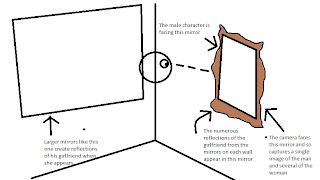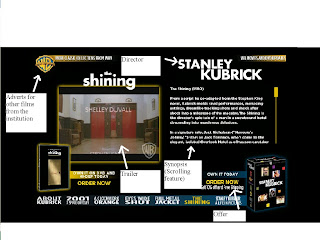During our recent lessons we have spent lots of time editing our first collection of footage into a rough edit of the teaser. There were some problems with the footage which we are in the process of solving currently.
Watching back the section where the hand turns off the fuse box was not convincing, because of the texture of the blood on the hand being too gloopy and an odd colour. Also, even if the blood looked realistic, there was an agreement between everyone in the group that the scene did not properly convey the nature of the monster (since it was just a human hand that could not properly be shown to relate to the woman in the house within the restrictions of the shots. Also the nature of the action in this scene did not provide the shock tactics we were aiming for in the final teaser.
To correct this we have pulled the scene altogether. As teasers generally last between 30 seconds and 1 minute and 30 seconds this has provided us with more space to develop the content of another scene which I will describe next.
Our most conventional scene and the most popular scene within the group consisted of a young male character dressing up in a room with the walls covered in mirrors; one minute everything would be normal, and by intersecting this scene with the one set in the forest, we can make the moment where his dead ex-girlfriend appears more shocking with the accompaniment of a very quick fading transition and an alarming sound effect. Because there is no visual description of this scene on the blog as yet, here is a basic explanation (click to enlarge):

The way that it looks like there are several copies of the girl in the room give an effect of the male character being surrounded. The girl is intended to be a form of the monster, built up from the male character's subconcious, because he is grieving his ex-girlfriend, and she is what he is thinking about at that time which is what creates the particular form the monster assumes. This is what leads to the problem with this shot. At the time of writing, we only have a static sequence where the girlfriend suddenly appears. Our feedback after showing this to our teacher was that if she was a construct of his mind (to some extent), we have not made this clear in what we have filmed so far.
To solve this we could do a number of things. After some research, a common way of taking the viewer into the character's mind is a close-up shot. But we could take this further by zooming in to the character's face (or even their eye, for example if we were to be explicit in showing this is in the character's mind) and when the shot reaches the level of zoom we want it to, the shot can suddenly change and reveal the girl, making it clear that after we have passed through the character's mind, we see what he imagines.
Alternatively, we could use editing to solve this problem. Warping the shot or soundtrack in a very subtle way could give the effect we are looking for, by distorting the reality of the shot which we have at the moment, the audience can tell it is being skewed in some way and the obvious assumption is that the character's mind is perceiving events that are not reality.
The camping/forest scene that was partially described in the storyboard post was believed to be effective by our group and teacher, but one issue was that it would have been a lot more unsettling and conventionally frightening if it was shot at night. Our experiences last year of filming at night were that we needed some kind of low-key light source to make sure that the fact it is being lit is not distracting from the action. The location of the camping scene was far from any street lamps or unnatural light, so it is very difficult to make it light enough to see, but not look like it is artificially lit. Currently we are thinking of re-filming this scene as well, by adjusting the white balance on the camera we think it will enable us to shoot a visible scene at night.
Aside from these main issues, there are instances in our footage where a camera is visible in a reflective surface, for example. To iron this out at the editing stage compromises other elements of the shot if we are cropping, so we have decided to film this section again. This also gives us a chance to improve the connection between the two characters in the sequence and give a greater sense of the action happening in the male character's mind.













